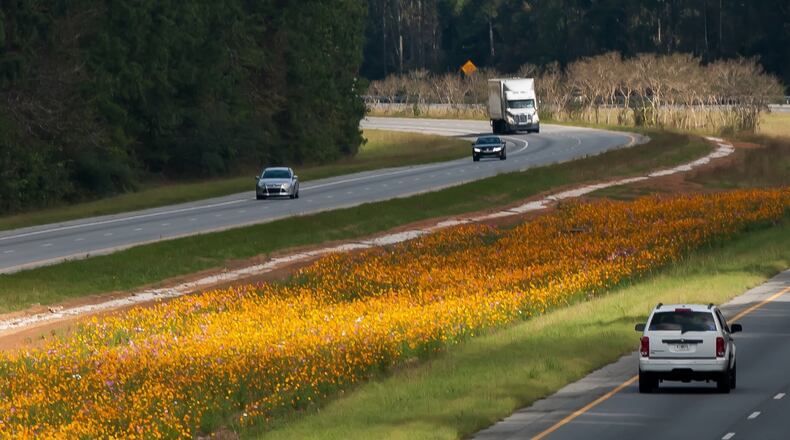Recently I seemingly awoke from a daze while driving Interstate 85 north of Columbus, Ga., beautiful Pine Mountain was in the distance and a sea of yellow orange lavender and pink was almost iridescently glowing in the middle of the divided highway. I went back the next day, got out of the car and walked to the middle surround by thousands upon thousands of cosmos flowers. I have to admit it was exhilarating and The Greatest Show on Earth, especially to a nature kind of guy.
Last year the Georgia Department of Transportation is taught all of us about the old floral favorite Cosmos bipinnatus that needs to be brought back to the garden. This cosmos is an annual easy to grow and drought tolerant can comes in shades of lavender, rose, pink and white. This year GDOT taught us about the false theory on some color combinations such as pink and rose don’t work with yellow and flaming orange. These long stretches of an already scenic highway dazzled with colors reminiscent of a desert sunset.
So, you gather that this year they combined the Cosmos bipinnatus or Mexican aster with the flaming hot colors of the Cosmos sulphureus or Sulphur cosmos. The partnership is staggering in its beauty. This cosmos is similar in that it is from Mexico, grown as an annual and tough-as-nails. The fact that the winds and torrential rains from Hurricane Michael didn’t faze them has to be considered a testimony to their durability.
GDOT has been revved up on planting for pollinators along the highway system, and if the powers to be saw what I did they should be doing the happy dance, high-fiving and planning for the years to come. I’ll tell you straight-up I was surprised when I walked to the middle of the flowers. There were more Monarch’s than I could count. There were also Common Buckeyes everywhere along with Gulf Fritillaries, Sulphurs, Skippers and an assortment of bees and wasps.
Cosmos gets its name from the Greek word kosmos as in beautiful, decoration and ornament. Indeed, they are dazzling in the cottage garden, cut-flower garden, backyard habitat and along the road ways. Cosmos have daisy-like flowers 2 to 4 inches in width with orange centers. You’ll find some selections of Cosmos sulphureus bearing double flowers. They are so easy to grow from seed, you can sow successive plantings to have blooms the entire growing season, especially if you want to have a bounty of flowers for the vase too.
Next spring plant your seeds or nursery-grown transplants into loose, well-drained soil. Fertility need not be high for this Mexico native. Seeds germinate in five to seven days with blooms, bees and butterflies in eight to 10 weeks. Thin the seedlings or space transplants 12 to 36 inches apart depending on your variety.
A web search will reveal a lot of varieties of both the Cosmos bipinnatus and the Cosmos sulphueus. Like the GDOT, don’t be afraid to plant both species of this Aster relative together, it just may make your show complete. Although considered an annual, the cosmos gives a perennial-like performance by reseeding, which is perfect for the highway system and your pollinator garden too.
These are tough plants, so water sparingly but when you do, water deeply, training those roots to go deep. Your volunteer seedlings may look a little different than what you originally planted when it comes to height, but they will nonetheless be dazzling. Sizzling partnerships can be created with blue forms of Salvias and Agastache also called anise hyssops and hummingbird mints.
———
(Norman Winter, horticulturist, garden speaker and author of, “Tough-as-Nails Flowers for the South” and “Captivating Combinations: Color and Style in the Garden.” Follow him on Facebook @NormanWinterTheGardenGuy.)
About the Author
Keep Reading
The Latest
Featured


